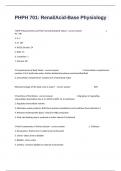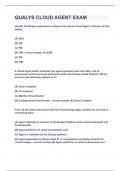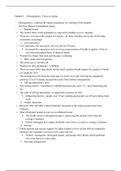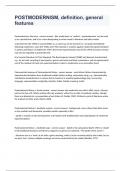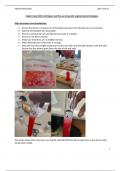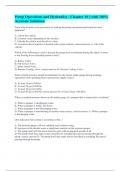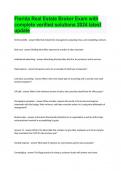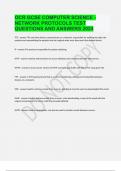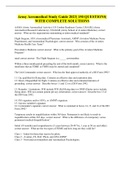7 BMP Measurements and Their Normal/Standard Values - correct answer 1.
Na- 140
2. K- 4
3. Cl- 104
4. HCO3 (bicarb)- 24
5. BUN- 15
6. Creatinine- 1
7. Glucose- 80
2 Compartments of Body Water - correct answer 1. Extracellular compartment-
contains 1/3 of total body water, further divided into plasma and interstitial fluid
2. Intracellular compartment- contains 2/3 of total body water
What percentage of the body mass is water? - correct answer 60%
5 Functions of the Kidney - correct answer 1. Big player in regulating
extracellular electrolytes (Na, K, Cl, HCO3 in BMP, H+ in acid-base)
2. Regulates extracellular volume
3. Eliminates waste products- BUN (from protein metabolism) and creatinine (from skeletal m.)
4. Releases erythropoietin (Epo)- critical for RBC production
5. Final rate limiting step in synthesis of active vitamin D (calcitriol)
5 Main Components of Urinary System - correct answer 1. 2 Kidneys
2. Renal pelvis- fluid in here is called urine at this point
3. Ureter- takes urine to bladder
4. Bladder- stores urine
5. Urethra- connects bladder to external environment
,Gross Anatomy of Kidney - correct answer 1. Arterial blood enters via renal a.,
venous drainage is via renal v.
2. Cortex= outer portion
3. Medulla= inner portion
4. Collecting ducts of inner medulla coalesce to form renal papilla
5. Fluid in papilla is no longer modified and is thus called urine
6. Papilla coalesce (join together) to form renal pelvis
Nephron - correct answer functional unit of the kidney, all sections lined by
epithelial cells, distal part of nephron (late DT and CCD) have principal cells and intercalated cells
Pathway of Flow Within Nephron - correct answer blood comes in from renal
a. thru afferent arteriole (AA)--> glomerular capsule (GC)-->comes out thru efferent arteriole (EA)--> EAs
join togeth to bring blood out ultimately forming renal v., from GC--> fluid moves into Bowman's space
(BS)--> proximal tubule (PT)--> descending thin limb of loop of Henle (DTL)--> ascending limb of loop of
Henle (ALH)--> ascending thick limb of loop of Henle (ATL)--> macula densa (MD)--> distal tubule (DT)-->
cortical collecting duct (CCD)--> medullary collecting duct (MCD)
Cortical Nephrons vs. Juxtamedullary Nephrons - correct answer 1. Cortical-
most nephrons are these, have loop of Henle that barely gets into medulla, network of capillaries
surrounding it called peritubular capillaries
2. Juxtamedullary- have long loops of Henle, network of capillaries surrounding it called vasa recta
Where do collecting ducts run? - correct answer run thru the medulla-->
coalesce to form papilla
Renal Corpuscle - correct answer tissue surrounding afferent arteriole (AA),
glomerular capillaries (GC), efferent arterioles (EA), and Bowman's space (space outside GC)
3 Parts of Juxtaglomerular (JG) Apparatus - correct answer 1. Granular cells of
the afferent arteriole (AA)
2. Macula densa (MD)
,3. Extraglomerular mesangial cells (no functional role)
Function of the JG Apparatus - correct answer granular cells release renin-
enzyme that converts angiontensinogen to AngI--> AngI rapidly converted to AngII by ACE, so if renin
goes up--> AngII goes up
3 Stimuli for Renin - correct answer 1. Reduced perfusion pressure to kidney
(BP falls)
2. Activation of symps (beta 1)
3. Reduced NaCl delivery to macula densa
Glomerular Capillaries - correct answer very leaky capillaries so Kf (filtration
coefficient) is high, have negative charges on them that prevent proteins from crossing so sigma
(reflection coefficient) is high, therefore the GCs filter a lot (since high Kf) but don't filter proteins (since
sigma is high)
Nephritic Syndrome - correct answer inflammatory interaction in GCs where
fluid cannot easily filter thru capillary membrane around RBCs--> 5 signs:
1. Hematuria (RBCs in urine)
2. Proteinuria (protein in urine)
3. Oliguria- not filtering much so low urine output
4. HTN- if not filtering, then not regulating extracellular enviro so BP goes up
5. Azotemia- if not filtering, then not getting rid of urea
Nephrotic Syndrome - correct answer alteration in GC membrane, 5 signs:
1. Marked proteinuria- alteration allows proteins to pass
2. Edema- proteins keep water in vasculature so if they're lost, more fluid comes out
3. Hypoproteinemia- low proteins in blood since losing them in urine
4. Lipiduria- lipid soluble cmpds travel on proteins, so you'll have lipids in urine
5. Hyperlipidemia- see increase in lipids in blood
, What is the #1 cause of kidney problems? - correct answer diabetes mellitus
4 Basic Renal Processes - correct answer 1. Filtration (F)- from GC to BS
2. Reabsorption (R)- from lumen of nephron into capillary (peritubular or vasa recta)
3. Secretion (S)- from capillary (peritubular or vasa recta) into lumen of nephron
4. Excretion (E)- appears in urine and eliminated from body
Overall Equation of the Basic Renal Processes - correct answer what gets
excreted= (amount filtered-any reabsorption) + any secretion--> E= (F-R)+S
About how much water is filtered and excreted by the kidneys daily? - correct answer
180L filtered, 1.8L excreted--> rest of it got reabsorbed
About how much sodium is filtered and excreted by the kidneys daily? - correct answer
630g filtered, 3.2g excreted
About how much glucose is filtered and excreted by the kidneys daily? - correct answer
180g filtered, 0g excreted because the kidneys don't regulate glucose
About how much urea is filtered and excreted by the kidneys daily? - correct answer
56g filtered, 28g excreted--> this is about 50% because urea is a waste product so kidneys want to get
rid of it
Pathway of Renal Hemodynamics/Blood Flow - correct answer comes in AA-->
GCs--> EA--> peritubular capillaries/vasa recta
Overview of Renal Hemodynamics - correct answer 1. 2 Resistors (arterioles) in
a series- AA and EA
2. 2 Capillary beds (glomerular and peritubular)
3. 2 Capillary pressures- glomerular (PGC) which is the upstream P ~60 and also peritubular (PPC) which
is the downstream P ~20
4. High resting flow- 25% of CO

